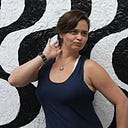20 Days of Goddesses til’ Imbolc
Day 14 — The Morrigán (Goddess of war, death, fate, prophecy, The Phantom Queen)
The Morrígan is the Irish goddess of death and destiny. Appearing before great battles as the goddess of fate, the Morrígan offered prophecy and favor to heroes and gods alike. As the Phantom Queen, she circled the battlefield as a conspiracy of ravens to carry away the dead.
She looked over the rivers, fresh water and lakes. She is also described as being the patroness of revenge, magic, priestesses, night, prophecy and witches. She was at once both a single deity and a triple goddess, made up of Ireland’s most powerful goddesses.
The Morrígan was first and foremost a goddess of war and death. She was also the goddess of prophecy and fate, and as such saw the future of all things, including the end of the world. She was all-knowing, and would occasionally share her knowledge with others (for a price). Her prophecies were never wrong and her wordings were exact, if somewhat poetic. Her appearance to royalty and warriors also represented the side she favored in a battle. The Morrígan’s association with the raven stemmed from the bird’s constant presence on the battlefield.
The Morrígan was a shapeshifter who took many forms; she would often appear in multiple forms throughout a single story. The most common of these forms were a shapely maiden, a battle ready warrior-queen, an old crone, and a raven. While she could take the form of other animals beyond a raven, the Morrígan did so less frequently.
One of the most prominent aspects of the Morrígan was her nature as a triple goddess of war. In many stories, she appeared as both an individual and as three goddesses acting under a single name. In Celtic mythology, the number three has incredible significance. At times, Morrigan is featured as one of three sisters while other times she is a singular figure.
The Morrigan included Badb, Macha, Neiman and occasionally Anu (whom might have been the crone aspect of Badb). Furthermore, depending on the text, Badb and Macha and Nemain might have been the same entity. However, I have included some aspects of each for clarity.
Badb: A war Goddess associated with battle, destruction, and death and often appeared over battle as a hooded crow, or ran alongside warriors disguised as a grey-red wolf. Badb was connected to rebirth as a watcher of the cauldron of regeneration in the Otherworld. She was also a Witch and a sorceress, and a Prophetess who foresaw the future.
Macha: The root word “mag” translated means field, plain or pasture. This name connects and gives Macha power over the sacred land and horses, representing wealth, power and symbolizing the elite warriors. As part of the trinity, she rained down fire and blood on her enemies.
Nemain: Her name translates to panic, frenzy or venomous. Also a deity of battle, death and destruction, she appeared as a carrion crow. Neiman was a prophetess and her battle cries meant death would soon follow. This aspect connects to the role of Banshee.
Although it appears that Morrigan teaches us how to fight on the battlefield, if one looks as life as a battlefield, there is much more to learn. She challenges, tests, and encourages us to take action in our lives, to become stronger, to create change, to release what no longer benefits us, to fight for what we believe in and stand up for ourselves; to point out the truth, to change our fate or accept it, and to use our own power as Goddesses. She is a woman of influence, and although we cannot physically transform ourselves into other forms, we can in numerous other ways. This is a lesson anyone can learn.
The origins of the Morrígan seem to reach directly back to the megalithic cult of the mothers. The mothers (Matrones, Idises, Dísir, etc.) usually appeared as triple goddesses and their cult was expressed through both battle ecstasy and regenerative ecstasy. Later Celtic goddesses of sovereignty, such as the trio of Éire, Banba, and Fótla, also use magic in warfare.
Associations
Animals: crows, ravens, vultures, eels, wolves, cows and horses
Colors: red and black, white, purple, and dark blue
Stones: Obsidian, Rubies, jet, Amethyst, Garnet, bloodstone, Clear Quartz
Symbols: Three interlinking lines or inverted triangle
Herbs and plants: Blackthorn, Belladonna, Juniper berries, Nightshade, Dragon’s blood, Mugwart, Yew
Moon phase: New, dark, waning
Regions: Fords, rivers, lakes
Foods: Mead, milk, whiskey, apple, water, red colored foods
Colors: red and black
Elements: Fire and water
References:
https://en.wikipedia.org/wiki/The_Morr%C3%ADgan
